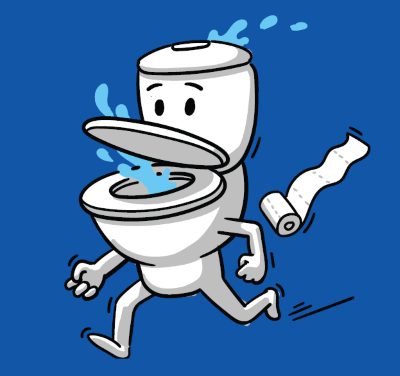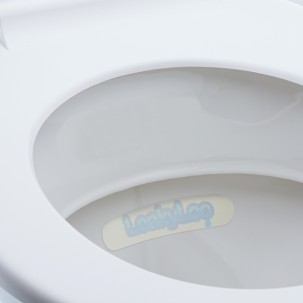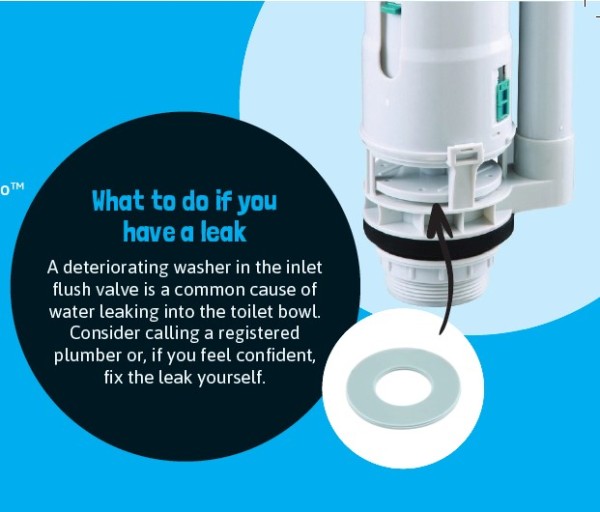Is your toilet running?


Not sure if your toilet is leaking? Here's what you can do:
- If you live in Hamilton City or Waipā District you can pick up your free leaky loo test strip from your council reception or local library.

- Alternatively, you don't even need to leave your home - so long as you have some food colouring you can try....the 'food colour leak test' watch the video.
- A common cause of a leaking toilet is a deteriorating flush valve, and this can be changed quite easily if you feel confident. There are many online tutorials with step by step instructions. Be sure to use a New Zealand site such as this one from Porirua City Council.

- If you are not confident with fixing a leak yourself, we recommend you call a registered plumber. This should cost no more than $150 to $200 for a simple leak repair.
Shower
- Shorten your shower. Each minute you add to your shower time uses about 12 litres of water. For a household of three that extra minute costs you about $90 a year in electricity.
- To help keep track of time, try using a shower timer. Contact us and we'll send you one for free!*
- Measure your shower flow rate - if it is more than 11 litres per minute, consider swapping your showerhead for a water-efficient one (provides the same shower experience but uses less water). Alternatively, for minimal cost, install a flow restrictor (available at any local DIY store).
- Don't just watch the shower warming up! Use a bucket in the shower to catch water as it warms up. It's easy to carry out of the house so you can keep thirsty herbs happy in summer.
*Free shower timer available to Hamilton City, Waikato District and Waipā District residents only.
A shorter shower saves water and power!
In this interactive quiz you have to move the parts of the bathroom to answer the questions and learn how much your household could save.
IS YOUR POWER BILL KILLING YOUR WALLET?
Bath
- When running the bath put the plug in first and adjust the temperature as the tub fills.
- Reduce the depth of your bath. The average amount of water used for a half full bath is 80 litres, compared to 140 litres for a full bath.
- Baths typically use more water than having a shower. However, did you know that a 10 minute shower is equivalent to a bath? If you feel like a long soak now and again, a bath may well be a better option.
- Use eco-friendly products and then you can reuse your bath water on your house plants or garden.
Toilets
- Check your toilet doesn't leak. Toilet leaks are often silent. A continuously running toilet can waste more than 700 litres of water a day and is not something you can ignore.
- Don't use your toilet as a rubbish bin. Only pee, poo and paper should be flushed, the rest should go in the bin.
- Use the correct dual flush option (half-flush for liquid waste and a full-flush for solid waste).
- Consider installing a toilet weight flush limiter if your toilet is pre-2005. This simple gadget gives you control of how much water is used each flush.
- Stand a full 2 litre plastic soft drink bottle in your cistern to save water every time you flush. This can achieve savings of up to 5,000 litres per year.
- When shopping for a new toilet, use the water efficiency labelling scheme (WELS) to help you choose. Just remember, the more stars on the WELS label, the more water efficient the toilet is.
Toilet cistern leak check
Don’t delay, check your toilet today.
Follow these simple steps and watch the video.
- Remove the toilet cistern lid.
- Put a few drops of blue or green food colouring into the cistern.
- Wait 15 minutes. if the water in the bowl has changed colour, you have a leak.
- Flush the coloured water away so it doesn't stain the toilet bowl.
- A deteriorating washer in the inlet or flush valve is a common cause of water leaking into the toilet bowl. Either call a registered plumber or if you feel confident, fix the leak yourself.
TAPS
- Turn off the tap when you are brushing your teeth.
- Rinse your razor in a plugged sink, not running water.
- Consider installing water aerators on all your bathroom taps.
- Turn the taps off tightly and check all your taps for leaks.
What’s Involved in a Professional Tap Repair?
- Isolate the water supply
- Carefully dismantle the tap and inspect components
- Replace washers, O-rings, or cartridges as needed
- Clean and reseat valve faces
- Test for pressure and leaks